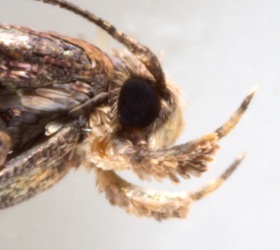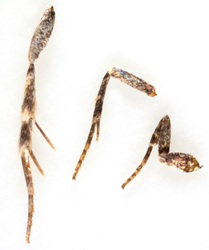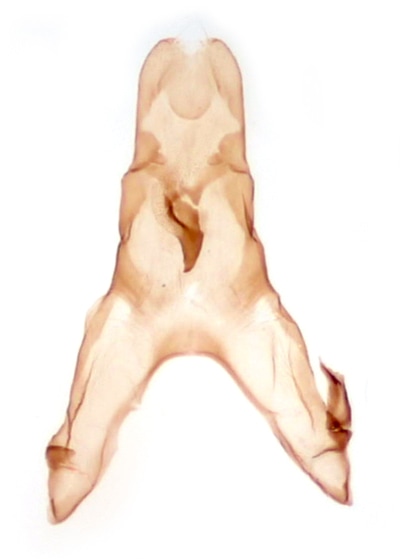|
GELECHIIDAE | Gelechiinae | Gnorimoschemini
|
35.118 Scrobipalpa ocellatella (Beet Moth)
ws: 11-15mm; bivoltine May-Jul, Aug-Oct; sea beet (Beta vulgaris maritima); coastal shingle and saltmarsh of S. England
ID: Said to be one of the more distinctive Scrobipalpa due to an impression of an angulate fascia at 3/4 (MBGBI4.2) but probably not confidently identifiable without genital examination.
Male genitalia: coremata absent; posterior margin of uncus truncate or concave; valva not exceding uncus.
Female genitalia: CB not clearly differentiated from DB > 4 species
These are separated in the key in MBGBI4.2 according to the presence/absence and distribution of a honeycomb pattern in the ventral zone of segment 8. This feature seems to require a higher power of magnification than is available to me. However, S.ocellatella is distinguished by having a very dense honeycomb pattern in the anterior 1/3 of the ventral zone - I believe this appears as dark a blotch in the images below (compare S.acuminatella which is distinguished by not having any honeycomb pattern).
S.samadensis is distinguished in the key in MBGBI4.2 by having the honeycomb pattern in the ventrolateral zone but not the ventral zone. It seems to me that it is more easily distinguished by having relatively long anterior apophyses (>1.5x length of body of segment 8 (?=sterigma); approximately = length in the other 3 species). S.pauperella has an even distribution of the honeycomb pattern in the ventral zone, which I suspect would not be easy to determine, however it is only known in GB from 7 specimens taken at Chippenham Fen in the 1970s.
Male genitalia: coremata absent; posterior margin of uncus truncate or concave; valva not exceding uncus.
Female genitalia: CB not clearly differentiated from DB > 4 species
These are separated in the key in MBGBI4.2 according to the presence/absence and distribution of a honeycomb pattern in the ventral zone of segment 8. This feature seems to require a higher power of magnification than is available to me. However, S.ocellatella is distinguished by having a very dense honeycomb pattern in the anterior 1/3 of the ventral zone - I believe this appears as dark a blotch in the images below (compare S.acuminatella which is distinguished by not having any honeycomb pattern).
S.samadensis is distinguished in the key in MBGBI4.2 by having the honeycomb pattern in the ventrolateral zone but not the ventral zone. It seems to me that it is more easily distinguished by having relatively long anterior apophyses (>1.5x length of body of segment 8 (?=sterigma); approximately = length in the other 3 species). S.pauperella has an even distribution of the honeycomb pattern in the ventral zone, which I suspect would not be easy to determine, however it is only known in GB from 7 specimens taken at Chippenham Fen in the 1970s.
§1 Foulness, Essex; 04/09/2011; female; fw 5.7mm
§2 St Marys, Isles of Scilly; 24/09/2011; male; fw 5.7mm
§3 Foulness, Essex; 08/09/2012; male; fw 5.9mm
§4 Foulness, Essex; 04/09/2011; female; fw 6.2mm
§5 Portland Bill, Dorset; 09/09/2018; male; fw 5.2mm
§6 Foulness, Essex; 25/05/2019; female; fw 6.2mm
§7 Westcliff-on-sea, Essex; 14/09/2020; male
All images © Chris Lewis
§2 St Marys, Isles of Scilly; 24/09/2011; male; fw 5.7mm
§3 Foulness, Essex; 08/09/2012; male; fw 5.9mm
§4 Foulness, Essex; 04/09/2011; female; fw 6.2mm
§5 Portland Bill, Dorset; 09/09/2018; male; fw 5.2mm
§6 Foulness, Essex; 25/05/2019; female; fw 6.2mm
§7 Westcliff-on-sea, Essex; 14/09/2020; male
All images © Chris Lewis
Page published 30/09/11 | §3 added 14/09/2012 | §4 added 08/05/2017 | §5 added 21/02/2019 | §6 added 13/02/2020 | §7 added 04/10/2020





































